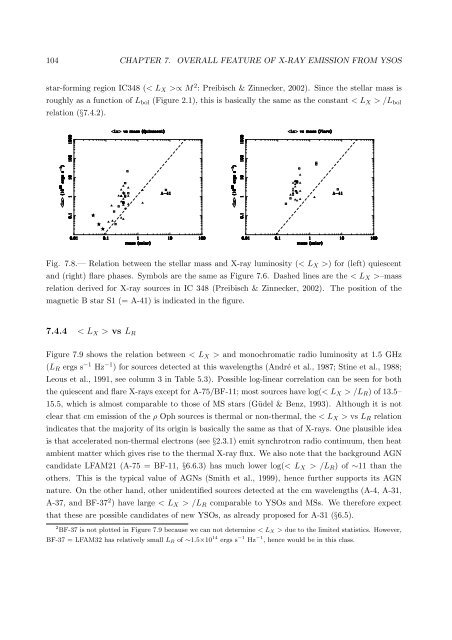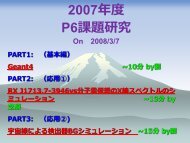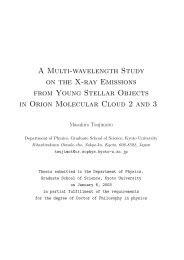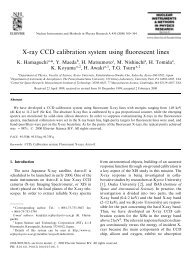X-ray Study of Low-mass Young Stellar Objects in the ρ Ophiuchi ...
X-ray Study of Low-mass Young Stellar Objects in the ρ Ophiuchi ...
X-ray Study of Low-mass Young Stellar Objects in the ρ Ophiuchi ...
You also want an ePaper? Increase the reach of your titles
YUMPU automatically turns print PDFs into web optimized ePapers that Google loves.
104 CHAPTER 7. OVERALL FEATURE OF X-RAY EMISSION FROM YSOSstar-form<strong>in</strong>g region IC348 (< L X >∝ M 2 : Preibisch & Z<strong>in</strong>necker, 2002). S<strong>in</strong>ce <strong>the</strong> stellar <strong>mass</strong> isroughly as a function <strong>of</strong> L bol (Figure 2.1), this is basically <strong>the</strong> same as <strong>the</strong> constant < L X > /L bolrelation (§7.4.2).Fig. 7.8.— Relation between <strong>the</strong> stellar <strong>mass</strong> and X-<strong>ray</strong> lum<strong>in</strong>osity (< L X >) for (left) quiescentand (right) flare phases. Symbols are <strong>the</strong> same as Figure 7.6. Dashed l<strong>in</strong>es are <strong>the</strong> < L X >–<strong>mass</strong>relation derived for X-<strong>ray</strong> sources <strong>in</strong> IC 348 (Preibisch & Z<strong>in</strong>necker, 2002). The position <strong>of</strong> <strong>the</strong>magnetic B star S1 (= A-41) is <strong>in</strong>dicated <strong>in</strong> <strong>the</strong> figure.7.4.4 < L X > vs L RFigure 7.9 shows <strong>the</strong> relation between < L X > and monochromatic radio lum<strong>in</strong>osity at 1.5 GHz(L R ergs s −1 Hz −1 ) for sources detected at this wavelengths (André et al., 1987; St<strong>in</strong>e et al., 1988;Leous et al., 1991, see column 3 <strong>in</strong> Table 5.3). Possible log-l<strong>in</strong>ear correlation can be seen for both<strong>the</strong> quiescent and flare X-<strong>ray</strong>s except for A-75/BF-11; most sources have log(< L X > /L R ) <strong>of</strong> 13.5–15.5, which is almost comparable to those <strong>of</strong> MS stars (Güdel & Benz, 1993). Although it is notclear that cm emission <strong>of</strong> <strong>the</strong> <strong>ρ</strong> Oph sources is <strong>the</strong>rmal or non-<strong>the</strong>rmal, <strong>the</strong> < L X > vs L R relation<strong>in</strong>dicates that <strong>the</strong> majority <strong>of</strong> its orig<strong>in</strong> is basically <strong>the</strong> same as that <strong>of</strong> X-<strong>ray</strong>s. One plausible ideais that accelerated non-<strong>the</strong>rmal electrons (see §2.3.1) emit synchrotron radio cont<strong>in</strong>uum, <strong>the</strong>n heatambient matter which gives rise to <strong>the</strong> <strong>the</strong>rmal X-<strong>ray</strong> flux. We also note that <strong>the</strong> background AGNcandidate LFAM21 (A-75 = BF-11, §6.6.3) has much lower log(< L X > /L R ) <strong>of</strong> ∼11 than <strong>the</strong>o<strong>the</strong>rs. This is <strong>the</strong> typical value <strong>of</strong> AGNs (Smith et al., 1999), hence fur<strong>the</strong>r supports its AGNnature. On <strong>the</strong> o<strong>the</strong>r hand, o<strong>the</strong>r unidentified sources detected at <strong>the</strong> cm wavelengths (A-4, A-31,A-37, and BF-37 2 ) have large < L X > /L R comparable to YSOs and MSs. We <strong>the</strong>refore expectthat <strong>the</strong>se are possible candidates <strong>of</strong> new YSOs, as already proposed for A-31 (§6.5).2 BF-37 is not plotted <strong>in</strong> Figure 7.9 because we can not determ<strong>in</strong>e < L X > due to <strong>the</strong> limited statistics. However,BF-37 = LFAM32 has relatively small L R <strong>of</strong> ∼1.5×10 14 ergs s −1 Hz −1 , hence would be <strong>in</strong> this class.

















